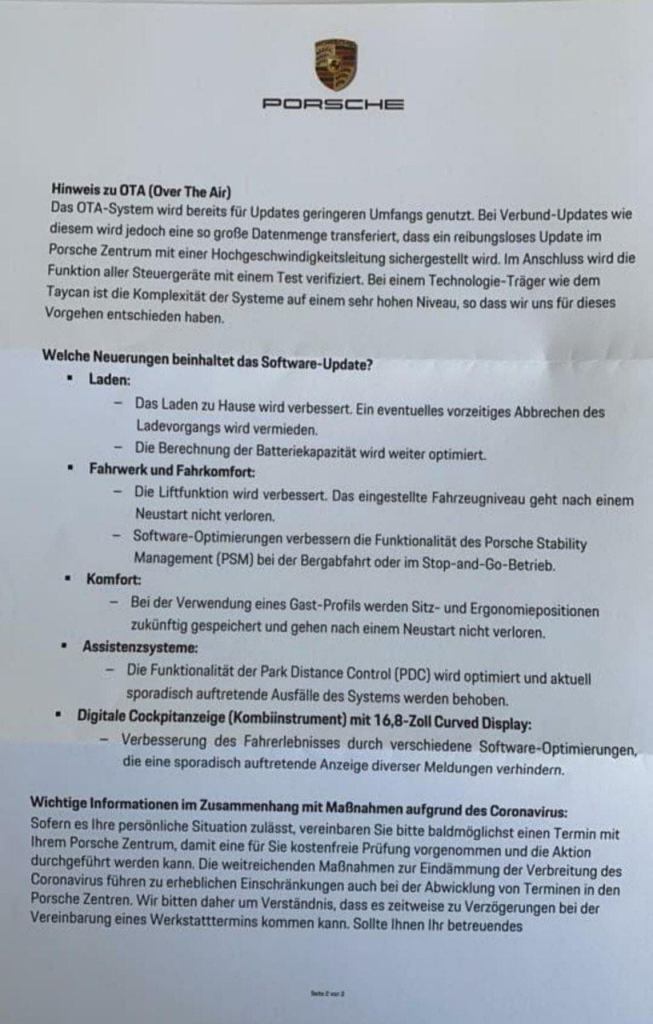While Porsche’s first all-electric production car, the Taycan, is taking home one award after another, it is the little things that show how far the Tesla challenger really has come. For example, Porsche praised the Taycan as “over-the-air update-enabled” for its customers, which means nothing else but that software updates are downloaded to the car via WLAN, as Tesla has demonstrated for years. This saves vehicle owners a visit to the workshop to receive updates and enhancements.
For comparison: Tesla sends a software update to the vehicles every two to four weeks, sometimes with completely new functions. To do this, you have to connect your vehicle to a WLAN and the software update is downloaded and installed. Such a process normally takes half an hour.
Porsche as the first competitor also announced this functionality, but the functionality does not seem to keep up with the promises yet. Taycan owners received a letter in which the vehicles are ordered to the workshop for a major software update. The justification is worth reading and shows the challenge traditional manufacturers are facing. Here is the text in its entirety:
Note on OTA (Over the Air)
The OTA system is already used for updates of a smaller scope. However, for compound updates such as this one, such a large amount of data is transferred that a smooth update in the Porsche Center is ensured with a high-speed line. Subsequently, the function of all control units is verified with a test. With a technology carrier such as the Taycan, the complexity of the systems is at a very high level, so we decided on this procedure.
Let’s take a closer look at this paragraph. The size of the software update has little to do with it. Tesla also transfers hundreds of megabytes and gigabytes of data, which every home broadband connection should be able to handle. The term “complexity” is revealing. It points to nothing more than that the Taycan still has a traditional electronics architecture from a manufacturer with a deep supply chain. This means that we are talking about a presumably three-digit number of Electronic Control Units (ECUs) sitting on each component supplied by a manufacturer, taking control and ensuring function.
Tesla has a deep vertical integration and manufactures a large number of components in-house, allowing the company to use a simplified electronics architecture with very few central ECUs and 2 AI chips, with updates entirely under Tesla’s control. A VW Golf, for example, has 75 ECUs, all from different manufacturers and under their control. A Porsche Taycan is said to have more than 100 ECUs. The cited letter refers to updates on a “lesser scale”, which probably means nothing else than “updates on ECUs that Porsche has under control”. “Composite updates” would thus be updates which also affect ECUs of suppliers.
The coordination of a software update with so many suppliers is certainly no honeypot and the Porsche management seems to have taken the easiest way to periodically order Taycan owners to the workshop for an update. The fact that Porsche itself has to adjust to a rhythm of software updates lasting several weeks is challenge enough. If dozens of suppliers have to be coordinated, the complexity increases enormously.
Given this electronic architecture, it is doubtful that Porsche will ever be able to deliver a real Tesla-like OTA with the current Taycan. To do so, Porsche would have to take control of the ECUs and remove most of them. This alone is an almost impossible task with the current supplier model. To do this, Porsche would also have to create deep vertical integration, in other words: build almost everything itself. And that seems unlikely from today’s perspective.
Whatever. Porsche is new and the company will learn. But to call the functionality over-the-air update now is bold. In view of the current court decision on Tesla’s autopilot and what it promises and keeps, it seems that Porsche has gone a bit too far with the term OTA.
Here the original letter (in German) as sent to the Taycan owners (thanks to Nicolas Boehmer)

This article was also published in German.

12 Comments